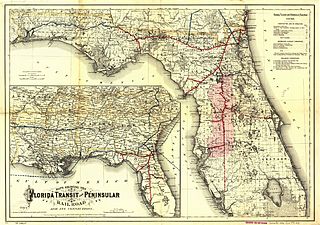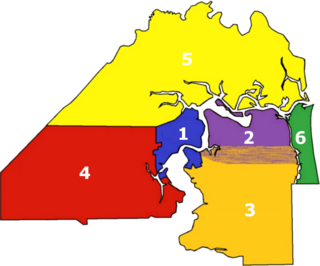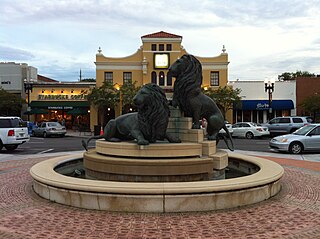Related Research Articles

Jacksonville is a city located on the Atlantic coast of Florida, the most populous city in the state, and is the largest city by area in the contiguous United States as of 2020. It is the seat of Duval County, with which the city government consolidated in 1968. Consolidation gave Jacksonville its great size and placed most of its metropolitan population within the city limits. As of 2020, Jacksonville's population is 949,611, making it the 12th most populous city in the U.S., the most populous city in the Southeast, and the most populous city in the South outside of the state of Texas. With a population of 1,733,937, the Jacksonville metropolitan area ranks as Florida's fourth-largest metropolitan region.

The Florida East Coast Railway is a Class II railroad operating in the U.S. state of Florida, currently owned by Grupo México.
The Atlantic, Suwannee River and Gulf Railroad Company was a railroad under the control of the Florida Central and Peninsular Railroad (FC&PR) that ran westward from Starke, Florida, eventually terminating at Wannee, Florida, on the Suwannee River. It was later absorbed by the Seaboard Air Line Railroad.

Prime F. Osborn III Convention Center is a 265,000-square-foot (24,600 m2) convention center located in downtown Jacksonville, Florida. Opened in 1986, it was built incorporating Jacksonville Terminal Complex / Union Station as well as several thousand square feet of newly built structure.

Springfield is a historic neighborhood of Jacksonville, Florida, United States, located to the north of downtown. Established in 1869, it experienced its greatest growth from the early 1880s through the 1920s. The Springfield Historic District is listed in the National Register of Historic Places, and contains some of the city's best examples of 19th and early 20th century architecture.
The Bytown and Prescott Railway (B&PR) was a railway joining Ottawa with Prescott on the Saint Lawrence River. The company was incorporated in 1850, and the first train ran from Prescott into Bytown on Christmas Day, 1854. The 84 km railway, Ottawa's first to outside markets, was initially used to ship lumber collected on the Ottawa River for further shipping along the St. Lawrence to markets in the United States and Montreal.

The Florida Central and Peninsular Railroad was the final name of a system of railroads throughout Florida, becoming part of the Seaboard Air Line Railway in 1900. The system, including some of the first railroads in Florida, stretched from Jacksonville west through Tallahassee and south to Tampa. Much of the FC&P network is still in service under the ownership of CSX Transportation.
Isaiah David Hart was an American plantation owner, and the founder of Jacksonville, Florida. Originally from Georgia, Hart took up arms against Spain in the Patriot Rebellion of 1812. After moving to a location near the cow ford on the narrows of the St. Johns River, he began platting the town in 1822, and later served as postmaster, court clerk, commissioner of pilotage, judge of elections, major in the local militia during the Seminole War, and as a Whig member of the Florida Territorial Senate. The Isaiah D. Hart Bridge over the St. Johns River in Jacksonville is named after him.

Downtown Jacksonville is the historic core and central business district (CBD) of Jacksonville, Florida USA. It comprises the earliest area of the city to be developed and is located in its geographic center along the narrowing point of the St. Johns River. There are various definitions of what constitutes Jacksonville's downtown; the one used by the city government and other entities defines it as including eight districts: the Central Core, the Southbank, LaVilla, Brooklyn, the Working Waterfront, the Cathedral, the Church, and the Entertainment & Sports District. The area features offices for major corporations such as CSX Corporation, Fidelity National Financial, TIAA Bank, Black Knight Financial, One Call Care Management, Suddath, Interline Brands Haskell, FIS, and Stein Mart.

There are more than 500 neighborhoods within the area of Jacksonville, Florida, the largest city in the contiguous United States by area. These include Downtown Jacksonville and surrounding neighborhoods. Additionally, greater Jacksonville is traditionally divided into several major sections with amorphous boundaries: Northside, Westside, Southside, and Arlington, as well as the Jacksonville Beaches.

The Bethel Church is a historically-black Baptist megachurch in Jacksonville, Florida, in the United States. Founded in 1838, it is the city's oldest Baptist congregation. The attendance is 12,000 members. The senior pastor is Bishop Rudolph W. McKissick Jr. The historic church building is on the National Register of Historic Places.

The Morocco Temple is a historic Shriners International building in Jacksonville, Florida. It is located at 219 Newnan Street, and was designed by New York City architect Henry John Klutho. On November 29, 1979, it was added to the U.S. National Register of Historic Places. The building is the oldest Shrine temple in Florida.

The Ocean Shore Railroad was a railroad built between San Francisco and Tunitas Glen, and Swanton and Santa Cruz that operated along the Pacific coastline from 1905 until 1921. The route was originally conceived to be a continuous line between San Francisco and Santa Cruz, but the 1906 San Francisco Earthquake, financial difficulties, and the advent of the automobile caused the line to never reach its goals, and remain with a Northern and Southern division.
U.S. Route 90 (US 90) in the state of Florida is the northernmost east–west United States Numbered Highway in the state. US 90 passes through the county seats of all 15 counties on its course in Florida, and it is also the road upon which many of the county courthouses are located. It is never more than six miles (9.7 km) from Interstate 10 (I-10) throughout the state. It runs as a two-lane highway through most of the sparsely populated inland areas of the Florida Panhandle, widening to four lanes through and near several towns. The speed limit is 55 mph (89 km/h) for all rural points west of Monticello, and it is 60 mph (97 km/h) on all rural points beginning in Madison County to Glen St. Mary.

LaVilla is a historic African American neighborhood of Jacksonville, Florida and a was formerly an independent city. It developed after the American Civil War and was eventually annexed to the city of Jacksonville in 1887 and is now considered part of downtown.

The Duval County Courthouse is the local courthouse for Duval County, Florida. It houses courtrooms and judges from the Duval County and Fourth Judicial Circuit Courts. The new facility is located Downtown Jacksonville, Florida; it was built starting in 2009 and opened in 2012.

The Jacksonville Fire and Rescue Department (JFRD) provides fire protection and emergency medical services for Jacksonville, Florida, as well as all unincorporated areas of Duval County.

San Marco is a neighborhood of Jacksonville, Florida, south of Downtown across the St. Johns River. The neighborhood was formerly the independent city of South Jacksonville until it was annexed by Jacksonville in 1932. The neighborhood is primarily residential, with an integrated commercial sector known as San Marco Square.

Laura Street is a north–south street in Jacksonville, Florida, United States, named for the daughter of the city's founder, Isaiah D. Hart. Historically, the downtown portion of Laura Street has been considered the financial district of Jacksonville.
References
- 1 2 Mann, Robert W. (4 November 2014). Streetcars of Florida's First Coast. Arcadia Publishing Incorporated. p. 30. ISBN 978-1-62585-247-2 . Retrieved 7 October 2017.
- ↑ "Randall et al. v. Jacksonville Street R.R.". Florida Reports. 19: 429. June 1882.